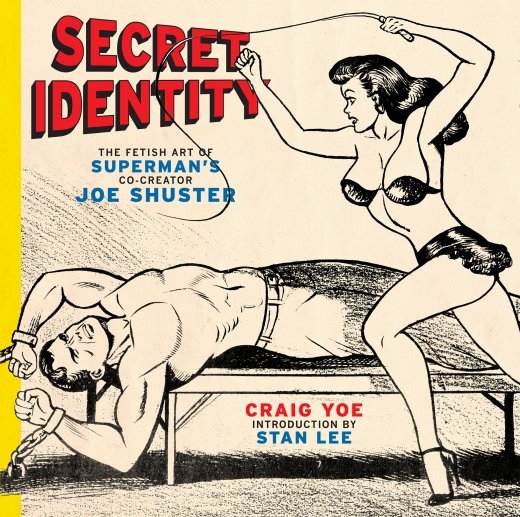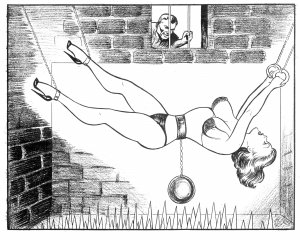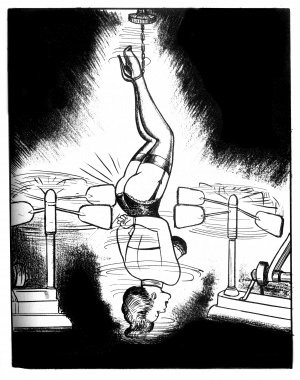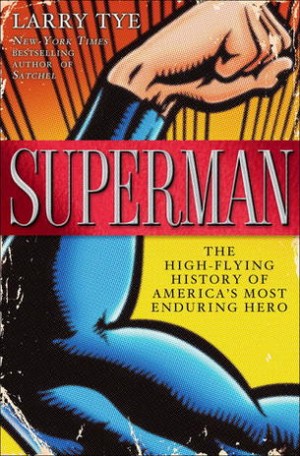Eighty years ago, Jerry Siegel and Joe Shuster created the iconic comic book character Superman, but it took several years of rejections before they finally sold him to Detective Comics Inc. in 1938. The distinctive superhero made his first appearance in the comics in June 1938 — and since then has appeared in radio dramas, TV shows, video games, newspaper comics and countless films. How has the Man of Steel evolved over the past eight decades — and what has made him so popular? Those were the questions that intrigued biographer Larry Tye, whose book Superman tells the story of the red-and-blue-clad icon who Tye calls “the longest-lived American hero of the last century.” “Americans embrace Superman partly because he captured so many things that are part of our psyche and part of our sense of ourselves,” Tye tells Fresh Air’s Terry Gross. “… He gave us an unwavering sense of right and wrong. He sweeps in to solve our problems. He was a bit like a Messiah in that he descended from the heavens to help us discover our humanity. And unlike all these other heroes — the dark Batman or the fraught Spider-Man — Superman was out there, always like a clear sign of light.” The story of Superman was created by Jerry Siegel, who grew up in a Jewish neighborhood in Cleveland and was often teased as a child. “Every day, when he’d go out on the school playground, kids would yell at him, ‘Siegel, Siegel, birds of an eagle,’ ” says Tye. “And he wished he would fly away. The only thing he could do was to escape into a world of fantasy and create his own kind of characters that could fly away.” Siegel’s earliest comics involved a character called The Super-Man, who was a bad guy trying to control the world. Later on, he dropped both the word ‘the’ and the hyphen — and changed Superman into a heroic character trying to save others from bad guys. MORE
***
BOOKS: Everybody’s Got Something To Hide

![]() BY JONATHAN VALANIA Joe Shuster was paid the princely sum of $130 by DC Comics (then called National Comics) for all rights and ownership of Superman — which he invented in his bedroom in Cleveland with the help of Jerry Siegel, his high school buddy from down the street. Even back in 1938, that wasn’t a lot of money, but Shuster was just glad somebody had finally bought into the concept of the Man of Steel after years of knocking on the doors of publishers, to no avail. Shuster and Siegel were tasked with creating future episodes of Superman, which, as history shows, was a super-hit with the comic book-buying public, drawing some 20 million readers by the early 1940s.
BY JONATHAN VALANIA Joe Shuster was paid the princely sum of $130 by DC Comics (then called National Comics) for all rights and ownership of Superman — which he invented in his bedroom in Cleveland with the help of Jerry Siegel, his high school buddy from down the street. Even back in 1938, that wasn’t a lot of money, but Shuster was just glad somebody had finally bought into the concept of the Man of Steel after years of knocking on the doors of publishers, to no avail. Shuster and Siegel were tasked with creating future episodes of Superman, which, as history shows, was a super-hit with the comic book-buying public, drawing some 20 million readers by the early 1940s.
Even though both Shuster and Siegel earned about $50,000 a year each in newspaper syndication royalties, both men deeply resented the gross disparity between what they were paid and what their creation earned for DC Comics and, after their initial 10-year contract with the comic book publisher concluded, endeavored to sue for a more equitable split. This ingratitude did not go down well with the powers that be at DC Comics and when the judge eventually ruled against Shuster and Siegel, both were promptly fired and their names removed from any future association with The Man Of Steel. Desperate for money, Shuster took a shady gig drawing up outlandish fetish scenes — whipping, spanking, cactus dildos, teen age sex cults, dope smoking, blood letting, foot-kissing, and bizarre bondage machines – to accompany the spicy tales included in Nights Of Horror, a low-rent smut fiction ‘zine that would raise the ire of both Congress and the Supreme Court, which duly issued an injunction against its sale and ordered all existing copies be destroyed.
Fortunately for modern-day preverts like you and me, Shuster’s fetish work — in which the guys all look just like Superman or Lex Luthor and the girls look just like Lois Lane — has been retrieved from the dustbin of history by comic book archivist/scholar Craig Yoe and handsomely repackaged in SECRET IDENTITY: The Fetish Art Of Superman’s Co-Creator Joe Shuster (Abrams ComicArts). It’s hard to say which is more shocking or surprising, the sadistic tableaux of Shuster’s forbidden art or the exceptional circumstances that triggered their creation and eventual destruction. Recently, Phawker got Yoe (pictured below, with keeper) on the horn and asked him to explain:
PHAWKER: First off, can you explain your haircut — it kinda looks like a standard ‘Moe’ with  fangs. Any explanation would be helpful.
fangs. Any explanation would be helpful.
CRAIG YOE: My agent was assured by the people at Phawker that my hair would not be brought up. It’s a birth defect. I have been tormented about this since grade school by bullies like you. Most polite adults look past this, you Phawker!
PHAWKER: Watch your mouth! I suppose it might come as a shock to some that the guy who created Superman also drew kinky bondage scenes, but it always seemed to me that all the superhero franchises were latent S&M, as is any ‘damsel in distress’ scenario.
CRAIG YOE: The superheroes are always flying around in tights and capes with their primary activity punching other guys in skin-tight tights and capes. Hm, I wonder if this whole concept is a wee bit kinky? The weird thing about the art in Secret Identity: The Fetish Art of Superman’s Co-Creator is how much the characters look like Superman/Clark Kent, Lois Lane, Jimmy Olsen and Lex Luthor–yet, of course, they aren’t!
PHAWKER: How did the saga of Nights Of Horror and Shuster’s involvement come to your attention? Was this an open secret amongst the comic literati passed along by word of mouth across the generations? And how did you manage to track down the artwork?
CRAIG YOE: I found one of the books in a old dusty cardboard box at a rare book dealers’ stand. I searched for the rest for a number of years contacting clandestine erotica dealers around the world and paying them big bucks. There were just a few of these printed in the first place, sold under the counter only in Times Square bookstores before the Supreme Court banned them. They’re rare, baby!
PHAWKER: If the Supreme Court injunction against Nights Of Horror was never formally lifted, is it not technically still in place — meaning this content is still technically illegal?
CRAIG YOE: Oh, geez. You’re right! I better get a good lawyer! The authorities eventually gave the publisher, mobster Ed/Edward/Eddie Mishkin, 3 years in prison for his activities. Now you’ve got me worried–and you better hide your copy!
 PHAWKER: Was Shuster literally illustrating the text of the stories or did he come up with the scenarios he depicted?
PHAWKER: Was Shuster literally illustrating the text of the stories or did he come up with the scenarios he depicted?
CRAIG YOE: I imagine, like comics, it was a collaborative experience between him and the writer/writers(?). There is some speculation…was there just one writer, the mysterious “Cla” or did perhaps Joe call in an old friend whom he might have worked with before to help on spinning these perverse tales?
PHAWKER: Is it possible that what inflamed the censors the most — given the sexist mores of the time — was the scenes of females dominating males?
CRAIG YOE: It was probably the whole enchilada, the whipping, spanking, cactus dildos, teen age sex cults, dope smoking, blood letting, foot-kissing, the crazy bondage machines, the searing of flesh with red hot metal rods, the lesbianism, smearing a woman’s hoo-hah with honey and then pouring red ants down her pants. One reviewer called the illustrations “charming.” Man, I’d like to go to the parties HE goes to.
PHAWKER: Just to be clear, I am devoutly anti-censorship and an avowed fan of Betty Page’s work, but just to play devil’s advocate (and setting aside the cynical manipulation of fear and panic, the shameless political grandstanding, the grotesque violation of the Constitution and the bending of pseudo-science to serve a fairly Victorian moral framework) did not the authorities have a point in that publishing depictions of S&M is what perpetuates its practice? After all, while it may well be that the impulses that fuel S&M may be embedded in our DNA, the rituals through which they are expressed — bondage, spanking, etc — are learned. I mean, Joe Shuster didn’t make up those scenarios out of whole cloth, he was merely re-imagining imagery he encountered in the pulp fictions of his boyhood. Discuss.
CRAIG YOE: All freedom-loving good Americans should rue the sad day the Nights of Horror booklets were banned by the Supreme Court. WHAT ARE YOU, SOME KIND OF PINKO-COMMIE?!”
PHAWKER: Okay, okay, back off, Yoe! Anyway, it’s hard to believe Joe Shuster was only paid $100 for an entire issue’s worth of illustrations. Any idea how long it would take him to do these drawings?
CRAIG YOE: Sounds lousy, but the ten illos in each booklet probably amount to a couple of comic  book pages of panels. It wasn’t all that bad for the time. It probably did take Joe some time as he was legally blind at the time. Joe likely had to struggle to achieve these but he must have been motivated–the results are sure and strong and the renderings quite beautiful, if extremely dark.
book pages of panels. It wasn’t all that bad for the time. It probably did take Joe some time as he was legally blind at the time. Joe likely had to struggle to achieve these but he must have been motivated–the results are sure and strong and the renderings quite beautiful, if extremely dark.
PHAWKER: From the photograph in the book, I see that the Jewish mobster Eddie ‘Sultan of Smut’ Mishkin, who published Nights Of Horror, wore sunglasses when he testified before Congress. Don’t you think that was a bad idea? I mean, that really makes you look guilty, like you have something to hide.
CRAIG YOE: And some kind of shark-skin suit. Right out of central casting. This book so needs to be a movie. Hope you have some big shot Hollywood producers reading Phawker!
PHAWKER: Has anyone ever told you that you have the same smile as Ed ‘Big Daddy’ Roth? I was lucky enough to interview him back in the early 90s before he died, rest his soul. He told me that when he was in the service he was a crewman on planes carrying atom bombs that drilled in the airspace above my hometown of Allentown, PA. Small world, huh?
CRAIG YOE: Roth drew a comic bio thing for me that’s wonderful that’s hasn’t been seen by many. And I designed a project with his monsters that he was highly complimentary of. It was a high point of my career. Some people are now calling Secret Identity: The Fetish Art of Superman’s Co-Creator Joe Shuster my low-point. Phawk ‘em!
PHAWKER: That’s the spirit!
(All artwork by Joe Shuster, courtesy of Abrams ComicArts. For more info, check out Craig Yoe’s Secret Identity blog. Craig Yoe photo by Adrian Buckmaster.)

